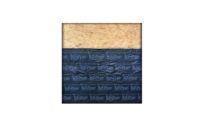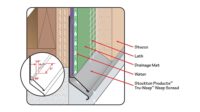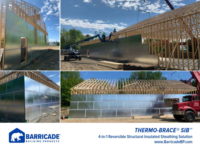During the summer months, we usually put a layer of sunscreen on to protect our skin from damage and burns, which can contribute to skin cancer. But why do we call it “sunscreen?”
Generally speaking, the term “screen” means a “barrier.” A barrier is like a block that provides a specific type of defense to reduce the level of damage from any negative climate impact. Most people might think the exterior cladding of a building should be able to provide the full barrier function required to prevent water leakage when it rains. Building construction professionals and scientists all know that unfortunately that is not the case: moisture will always find a way into a building’s enclosure, no matter how well the building was constructed or which specific cladding type was used.
When moisture penetrates, it can cause significant structural damage from rotting wood and pose serious health issues due to mold, both of which can become quite expensive when having to fix. According to ISO/Verisk Analytics, about one in 50 insured homes has a property damage claim caused by water damage or freezing each year.
These claims cost insurers about $9 billion a year. The average water damage claim costs about $8,860.
Weather Resistant Products
Therefore, an additional water-resistive barrier is utilized throughout the building industry to enhance the water management from the exterior cladding to the interior sheathing. Often that WRB is a standard layer of building paper between the cladding and sheathing. Though, as is the case with sunscreen, in-time and especially when contact with water and moisture comes into play, something more sophisticated and long-lasting is required.
Thus, through research and experience, building experts have developed what is known as a rainscreen wall and more precisely a ventilated rainscreen. Essentially providing a capillary break between the water-resistive barrier and cladding material, the space works to prevent water that has worked its way behind the cladding from remaining within the wall and damaging the sheathing. A rainscreen also allows a constant airflow that promotes drying and discourages the growth of mold and rot.
In the fight against the inevitable penetration, rainscreen provides the best defense by removing liquid water and water vapor as quickly as possible from within wall assemblies.
The protection level the rainscreen provides has caused many exterior cladding manufacturers to enact product installation requirements tied to their performance warranty that requires rainscreen to be installed in addition to the also mandatory WRB. Many municipalities around the United States, Canada and around the world have also begun to implement such requirements on all new construction and renovations.
As of 2015, the International Residential Code requires: “The exterior wall envelope shall be designed and constructed in such a manner as to prevent the accumulation of water within the wall assembly by providing a water-resistive barrier behind the exterior veneer, as described in Section 1404.2, and a means of draining water that enters the assembly to the exterior.”
It is often suggested that even if a rainscreen requirement has not been adopted by your local region, or is not mandated by the cladding manufacture, it is always wise to include the detail in the plans—as many architects have increasingly taken it upon themselves to do so throughout the years.
Rain Parade
Because the rainscreen requirements often aren’t an individually specified product or material—but a design feature detailed by the architect or designer and then left to the installer to fabricate themselves—the introduction of the rainscreen requirements often creates considerable confusion and at times can lead to delays which increase the project’s overall costs. This has led those in the building industry clamoring for an actual tested, specified product; one that has defined installation procedures across all material types and design features. One company that recently brought such a product to market is Tamlyn with their new TamlynWrap RainScreen line of products.
The product is a 3-in-1 water resistive barrier system that enhances the drainage efficiency and drying proficiency of a building through a unique three-dimensional matrix of extruded dot-textured building wrap based on the ProSelect Drainable Wrap substrate which allows draining and drying behind the exterior cladding systems. The product replaces and is installed in the same fashion as most commercially available WRBs.
Since product’s dot-textured cavity spacers are non-compressible, they provide the minimum rainscreen air gap between the sheathing and the cladding reducing the labor cost and excessive materials associated with a more traditional furring strip installation method. The two standard depths available are 6.3 mm (1/4 inch) and 10.1 mm (3/4 inch). The rainscreen 6.3 meets and exceeds the requirements of most building codes and performance needs. For areas in the country and Canada with stricter requirements and needs, particularly the coastal areas with high-precipitation, the manufacturer also offers its RainScreen 10.1.
The rainscreen allows for longer durability and sustainability of a building’s sheathing (i.e. OSB or coated OSB, plywood, etc.) and is engineered to be used for fiber cement siding, stucco, stone, and metal panel systems across many climate areas.









Report Abusive Comment